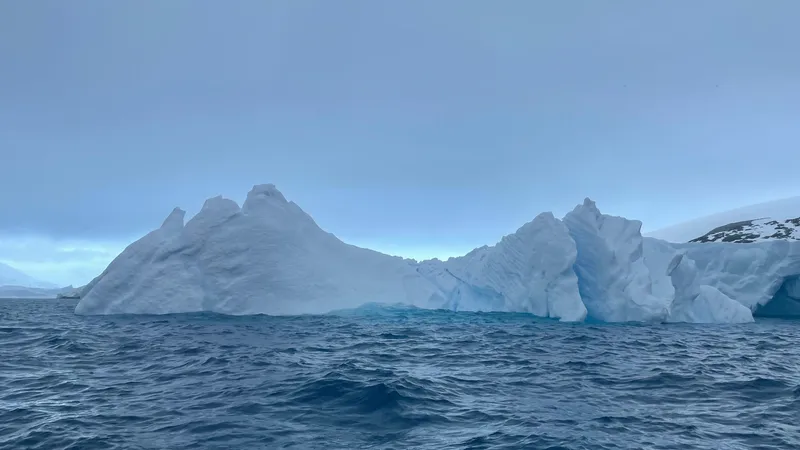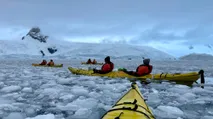Packing for an expedition to Antarctica can feel overwhelming, and for good reason. The environment there is not only harsh but also unpredictable, making preparation crucial for safety and comfort.
We embarked on an Antarctic expedition from December 21, 2021, to January 5, 2022. This article reflects what we learned from that experience, covering the gear we used and what we found essential during our adventure to the southernmost continent.
Aboard The Ship
While aboard the ship, the dress code is generally casual, except for the Captain’s Welcome Aboard and Farewell events, which are informal.
Casual clothing
During the day, you’ll likely be wearing sportswear or similar casual outfits. You never know when you’ll want to step outside to catch a glimpse of whales, so comfortable, flexible clothing is best. In the evenings, casual wear like open-neck shirts and trousers is typical, although many stick to sportswear even then.
Informal events
There’s no need for formal attire at the Captain’s events—just something a bit nicer than your everyday gear. A tie isn’t necessary, and since these events may occur during days at sea, I’d avoid wearing heels for practical reasons.
Ashore in Antarctica
The key to dressing for land excursions in Antarctica is staying warm and dry. You’ll also want to be mindful of preserving Antarctica’s ecosystem, so make sure your boots and clothes are cleaned thoroughly to prevent introducing foreign species or bacteria. The ship will conduct biosecurity checks, so don’t stress too much, but do be cautious.
The cold in Antarctica is not as extreme as many expect since you’ll be visiting during the summer. If you’re from a warm place like Florida, it might feel chilly, but if you’re accustomed to snowy winters, the 0°C (32°F) temperatures might feel mild. The wind is the real challenge, but outdoor activities will be canceled if the wind gets too strong.
Layering your clothing is the best strategy to adjust for the varying temperatures and activity levels. People have different tolerance to cold, so bring layers that allow flexibility. For more physical activities like long walks, you might need to shed layers, while for zodiac cruises, you’ll want to add an extra layer since you’ll be stationary.
Base Layer
The base layer is your first line of defense against the cold and goes directly on your skin. It’s important that this layer is breathable and moisture-wicking to keep you dry.
Merino wool and technical synthetics like Patagonia’s Capilene are the best choices. We prefer merino wool for its warmth and odor resistance, though synthetics are lighter and dry faster.
For merino wool base layers, you can choose from different fabric weights, which dictate the warmth. The chart below shows how these weights compare:
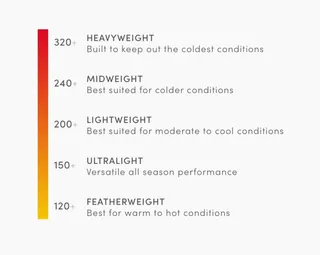
We found that lightweight merino wool (200-240g) was perfect for most days. You’ll be layering, so heavier fabrics might be unnecessary unless temperatures drop below -10°C (14°F). Here’s what we wore in Antarctica:
Women
- Icebreaker Merino Women’s 200 Oasis Long Sleeve Crewe Top
- Fjällräven Abisko Wool Long Sleeve
- Icebreaker Merino Women’s 200 Oasis Leggings
Men
- Icebreaker Merino Men’s 200 Oasis Long Sleeve Crew Neck Base Layer Top
- Icebreaker Men’s 200 Oasis Leggings with Fly
It’s best to bring at least two sets so you can rotate and wash them. Usually there are laundry facilities on the ship, but you might not have time to wash and dry your clothes.
Mid Layer
Your mid layer goes over the base layer to add warmth without bulk. Fleece is a popular choice here, and I prefer wearing two lighter fleece layers instead of one heavy one. This gives me more flexibility in regulating my body temperature.
Synthetic fleece is our preferred material because it’s lightweight and quick-drying. We found that a single fleece layer was enough during our trip, but for colder days or zodiac cruises, more warmth might be needed.
 Travelfoss
Travelfoss Travelfoss
Travelfoss
Here’s what we used for our mid during our Antarctic expedition:
Women
- Arc’teryx Women’s Delta Lt Jacket Women’s - a bit too light for colder days.
- Fjallraven Women’s Skare Half Zip - this can be used either as a base layer or as a mid-layer. I prefer using it on top of my merino base layer and under my full zip fleece on very cold days or for zodiac cruising.
- The North Face Women’s W Kyoshi Full Zip Jacket - my prefered mid-layer fleece.
- The North Face Under Knee Fleece Pants - could not find them on Amazon anymore.
- Adidas Long Fleece Pants - could not find them on Amazon anymore.
Men
- Salomon Men’s Outline Mid Jacket
- Fjallraven - Men’s Abisko Trail Fleece
- The North Face Men’s Borod Full Zip
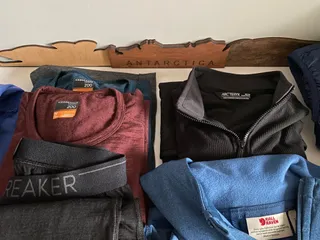
Insulation Layer
Many expedition ships provide a complimentary parka that includes an insulation layer. I only used mine on the coldest days or while zodiac cruising, but Stefan used his more regularly. Depending on the weather, you can layer the insulation under your parka or wear it alone on milder days.
Outer Layer
The outer layer is vital as it shields you from the wind and water. Most cruise ships provide a parka for their guests, so you only need to ensure it fits well. In case of bad weather before boarding, a lightweight rain jacket can come in handy, though we didn’t end up needing ours.
Waterproof pants are a must for zodiac landings, where you’ll step into water over your ankles. Make sure your pants fit over your boots to prevent water from seeping in. Ski pants, while insulated, are less effective at keeping out water compared to dedicated waterproof pants.
- Marmot PreCip Eco Jacket
- MARMOT PreCip Eco Full Zip Pant
- Insulated parka (provided aboard the ship on most cruises)
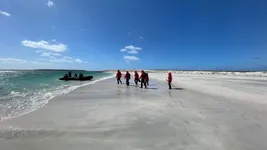
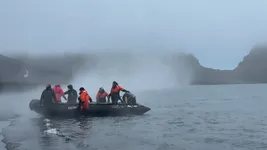
Footwear
For wet zodiac landings, knee-high rubber boots are essential. You’ll also walk on snow and ice, so boots with good traction and warmth are a must. Most ships offer boots for rent, but availability may vary, so check ahead. If you plan more expeditions, buying your own pair is a good investment.
The best boot options that we know of for Antarctic expeditions are:
We opted for the Muck boots due to availability in Europe, though Bogs are also highly recommended for traction and fit.
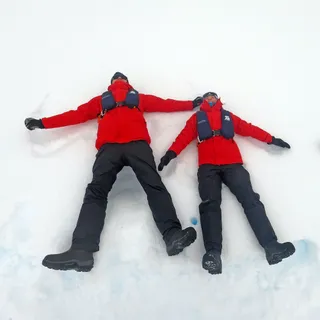
Hats, Gloves, Socks
- Fleece or wool hat (I prefer a neck gaiter)
- Neck gaiters are extremely versatile, you can use them to protect your neck from the cold and your ears and head as well. We usually have at least 2 pieces each in case of bad weather to add some insulation for our necks and ears if the hat is not enough. The neck gaiters that we use are the following: FJALLRAVEN Bergtagen Neck Gaiter, Salomon Unisex-Adult Rs Warm Tube, Icebreaker Merino Adult Unisex Flexi Chute Wool Winter Neck, North 66 headband (not on Amazon), and Salomon neck & head light gaiter unisex (no longer available).
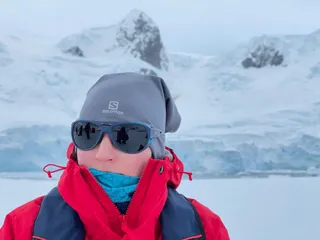
- Heavyweight socks are recommended not only for warmth but for cushioning inside the boots: Icebreaker Hike+ Heavy Crew Sock.
- Thin sock liners
- Waterproof heavy gloves (ski-type): Salomon Force Dry W, Salomon Men’s Standard Propeller Dry Glove. We strongly recommend getting some good gloves with Gore-Tex, like the second option. Otherwise you might risk having your gloves completely wet.
- Glove liners: Salomon Gloves Agile Warm Unisex. We weren’t cold enough to use the thin gloves under the heavy ones. We did used the glove liners under the kayaking gloves and sometimes on the outer deck.
- Hand and foot warmers: Hand Warmers, Foot Warmers - we were not cold enough to use them, but we saw other people having this kind of things.
Accessories
- Sunglasses are a must in Antarctica. The sun can shine and the ice reflects a lot of light which can be harmful to unprotected eyes. Even on a cloudy, day if the clouds aren’t thick enough, the light will be too bright. You need a pair of polarized sunglasses with a UV filter. Metal frames are not recommended since they can get cold and harm your skin. It is also good to use a strap to have the sunglasses tied behind your head to prevent losing them. Just like on a glacier or Mont Blanc, the bright light is everywhere, so lateral covers for the sunglasses are also highly recommended. Our go-to option was the Julbo Explorer 2 glasses with Reactiv High Mountain 2-4 Photocromatic, Polarized lens, also known as camel or cameleon lens, although we are not 100% satisfied with them.
- Trekking poles are good for increased stability when walking on ice or snow if you are unstable on your feet. We are both sure-footed and we didn’t need them. We already discussed how to choose your trekking poles in another article about hiking gear. If you are unsure, check with the company that you are cruising as they might have poles for rent so you don’t have to carry them for nothing.
- Binoculars are the best way to watch wildlife close up without disturbing them. We like traveling light, so we went for the small Olympus 8x25 WP II Binocular.
- Sunscreen - yes, the sun is strong if you’re lucky to have sunny days.
- Protective lip lotion - cold, dry air and high winds are not friendly with your lips.
- Motion sickness remedies
- Zip-seal bags to keep the camera and phone dry
- Lightweight and waterproof backpack - if not provided on ship.
- Bathing suit sounds a bit weird, but the polar plunge is a common thing in these expeditions to Antarctica.
The Antarctica Essentials Packing Checklist
We’ve shared our insights to help you pack for an Antarctic expedition. To make it even easier, grab our detailed packing checklist:
 Google Docs
Google Docs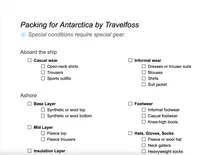
Additional Travel Packing
Besides the essentials that you need to pack for Antarctica, you may need to pack some regular stuff that you use on a daily basis when traveling. We have a travel packing checklist and also some tips & tricks for travel packing that you might like. In case you are interested you can check all our articles related to travel packing:
 Travelfoss
Travelfoss
That’s about it, I hope you found our checklist useful. If you consider that we should add anything to this list please let us know in the comments below.
For more Antarctica resource check out our other articles:
 Travelfoss
Travelfoss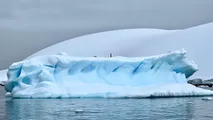
Related Travel Articles
- 7 Unique Travel Destinations for 2024
- Top Questions About Antarctica Expedition Cruises
- How To Choose Your Cruising Company To Antarctica
- What Are The Excursions You Can Do In Antarctica?
- What You Should Expect From Landings In Antarctica
- What You Should Know Before Booking a Cruise to Antarctica
- The Best Expedition Cruises in Antarctica
- What To Expect From Zodiac Cruising In Antarctica
- What You Need To Know About Kayaking in Antarctica
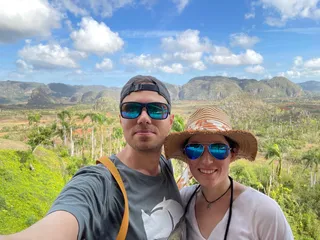
Writing free, independent and personal travel content since 2021. If you appreciate what we do, then you can return the favor by using the affiliate links below.
- Get your accommodations on Booking.com
- Buy your gear and gadgets from Amazon
- Book flights using Expedia
- Book activities on Get Your Guide
- Book guided trips on G Adventures
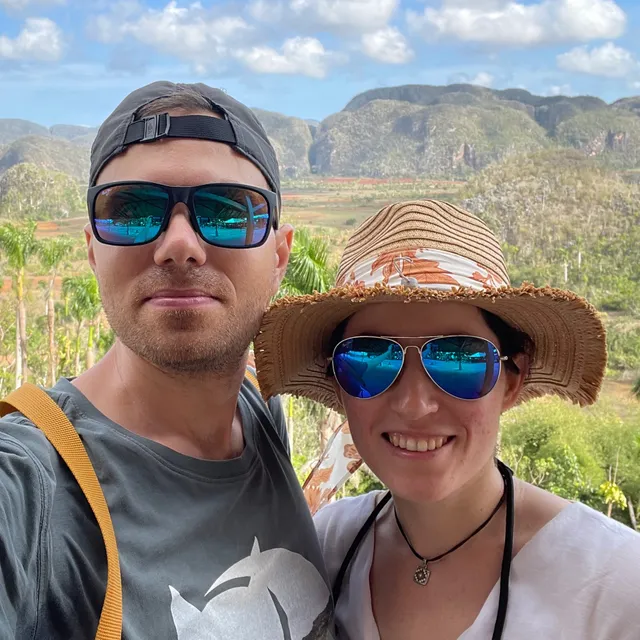
Writing free, independent and personal travel content since 2021. If you appreciate what we do, then you can return the favor by using the affiliate links below with no cost for you.
